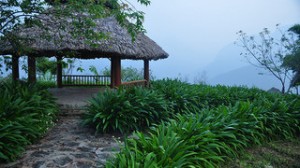Ecotourism is a phenomenon that has grown substantially in the last thirty years. It has reached countries all around the world from Central and South America to Asia. And with its growth has come a growing interest in whether or not ecotourism is as successful as it is thought to be.
Ecotourism grew from being just about protection of the environment to include protection of the local communities. But there has been the potential of actually doing more harm than good in that sense. A case study by Mike Stone and Geoffrey Wall was done on ecotourism in Hainan, China, where a park intended for conservation was built. According to their study, “at least one quarter of residents surveyed indicated that the park has had no effect or only negative effects (mainly in terms of lost jobs and land) on their lives.” The residents tend to be the ones that suffer when ecotourism becomes more prominent in the community, even if it is intended to help them.
On the other hand, there is traditional tourism which comes with its own positive and negative aspects. Cevat Tosun explored the impacts of tourism in Urgup, Turkey, where he found that “current research indicates that tourism as a factor of change can affect traditional family values, cause cultural commercialization, increase the crime rate, and lead to negative elements such as prostitution and gambling.” Traditional tourism, which does not take the community into great consideration, can have significant negatives on the locals.
From the architectural side, there is a thought process that embodies the ideals of ecotourism that not only benefits the owner of hotels, but also the locals. Luz Letelier and Pietro Stagno are architects who have done several projects throughout Costa Rica. Their primary focus is on sustainable building. They create a sustainable building by “attending to the social, economic and environmental aspects of the project in an integrated manner.” All aspects must fit together in order to create a more cohesive environment. For these architects, the social aspects of a project cannot exist without the economic aspects of a project.
The architectural aspects also present the advantages and shortcomings of both ecolodges and traditional hotels. In order to be truly sustainable, according to Stagno and Letelier, a building must be located on “land that has already been impacted so that the surrounding natural preexisting conditions can remain untouched. So unless the property has existing clearings and/or construction, cutting away trees and leveling ground is very damaging in these locations.” For travelers, this means it is important to keep in mind where these hotels are located. Even if they are managed in a sustainable fashion, it is possible that hotels are not as sustainable as one would think if land had to be cleared for them, which presents the idea of greenwashing, in which hotels advertise themselves as more sustainable than they actually are.
In terms of traditional hotels, Stagno and Letelier say that they can be sustainable in urban areas. Urban hotels have access to public transportation and the ability to use an already- existing site. However, in order to be seen as truly sustainable in an urban setting, the hotel should take sustainability into consideration “from the beginning of the design process as well as control the construction process in order to reduce the hotel’s negative impact; specifically during the operation phase (integration with the community, giving employees qualification courses, the kind of food offered, cleaning procedures and detergents, management of water and energy, etc). is where such a project can really minimize its initial impact.” If a hotel, regardless of how large it is, incorporates these characteristics, it can, therefore, be considered sustainable.
However, in a non-urban area, Stagno and Letelier say, “a large hotel, with a monolithic building and a large quantity of guests won’t be as sustainable, or will take a lot more effort and time to reduce its impact through operational demands.” While such an establishment is sustainable in an urban location it is not sustainable in places where the ecosystem is more fragile and therefore cannot easily support such a large amount of people. In Stagno’s and Letelier’s opinion, these large corporate hotels are “very pro consumerist and disconnected with the reality outdoors” and as a result “it is like living in a bubble and nothing can be less sustainable than that attitude.”
In the tourism industry, then, the next step is for large corporations to take on the task of becoming more sustainable, not just in their current buildings but also in the buildings that are to come.
In China, a study was done by Pengpeng Xu and Edwin H.W. Chang, which shows that there is a way to retrofit existing buildings with technology to lower carbon emissions. According to the study, “Building Energy Efficiency Retrofit (BEER) is an attractive way toward low carbon buildings through improving energy efficiency of high-energy-consumption existing buildings.” The study examines the best way to market this method to hotels and other businesses in order to encourage such businesses to pursue the integration of this method.
If this method were integrated into hotels around the world, greenwashing would lessen as a marketing tool and instead, businesses could honestly cater to the needs and interests of environmentally- minded people.
If places like the Hilton, which is somewhat less expensive than an ecolodge, would incorporate more environmentally- sound methods for running the hotel, they would be more competitive with the nearby ecolodge while helping to sustain the environment and themselves.
While ecotourism and ecolodges are the most sustainable method of travel, it does not mean that it is the only sustainable method. Once big corporate hotels retrofit their existing buildings with sustainable technology, such as solar panels and rainwater catch systems, and integrate themselves with the community by, for example, providing locally grown food and paying a living wage, more people will become, by default, sustainable travelers. This is the next step in the growth of ecotourism.
